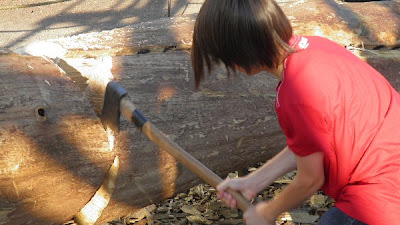 The same ship has been reconstructed before, but this time not only the ship is being copied, but the entire process of building it. The building process is shaped by knowledge about Vikings’ tools and techniques; knowledge about wood’s diverse qualities, as well as how it might have been affected by climate during the centuries of growing; knowledge about the ship’s lines, curves, joints, surface; hydrodynamic, waterproof and other qualities, and much more. In short, the reconstruction of the full size replica is a huge multidisciplinary project that calls on complex combinations of knowledge and expertise. Additionally, local knowledge is constantly being produces in here-and-now situations where physical work challenges craft-men and volunteers to master the tools and approach the materials (wood, iron or wool) in contextually appropriate manners. This means that they have to pay close attention to the exact qualities of the wood piece they have in hand, they have to adjust their movements according to the material, tool and muscles in their bodies… and to accomplish some kind of harmony between embodied knowledge, reflection and imagination in order to solve emerging problems - for instance: how to change axe’s angles when cutting across a 70 cm thick oak.
The same ship has been reconstructed before, but this time not only the ship is being copied, but the entire process of building it. The building process is shaped by knowledge about Vikings’ tools and techniques; knowledge about wood’s diverse qualities, as well as how it might have been affected by climate during the centuries of growing; knowledge about the ship’s lines, curves, joints, surface; hydrodynamic, waterproof and other qualities, and much more. In short, the reconstruction of the full size replica is a huge multidisciplinary project that calls on complex combinations of knowledge and expertise. Additionally, local knowledge is constantly being produces in here-and-now situations where physical work challenges craft-men and volunteers to master the tools and approach the materials (wood, iron or wool) in contextually appropriate manners. This means that they have to pay close attention to the exact qualities of the wood piece they have in hand, they have to adjust their movements according to the material, tool and muscles in their bodies… and to accomplish some kind of harmony between embodied knowledge, reflection and imagination in order to solve emerging problems - for instance: how to change axe’s angles when cutting across a 70 cm thick oak.
 I am telling this from my personal experience. Usually I use saw to cut wood, but Vikings did not have saws. Cutting wood "the Viking-way" seemed easy when we were shown how to do it; doing it oneself was a quite different experience – I am sure it was also different experience for each of us (my three 13 years old companions and me) who volunteered that day.
I am telling this from my personal experience. Usually I use saw to cut wood, but Vikings did not have saws. Cutting wood "the Viking-way" seemed easy when we were shown how to do it; doing it oneself was a quite different experience – I am sure it was also different experience for each of us (my three 13 years old companions and me) who volunteered that day.
I experienced how important it was to keep changing the angle of the blade in order to make a “V”-like shape (or rather “U”-shape, as learned through experience) through the wood; I experienced how loose I should hold around the handle in order to prevent hurting my wrists; which back muscles to engage; in which position to drop the axe; how to slide my hands along the handle in order to control to blade’s direction; how to find the right rhythm to provide the best efficiency, and so on… Each of the boys seemed to explore their own cutting technique, for instance banding and straitening knees in order to canalise power from feet up to the axe’s blade. They generally gave the most they had, claiming that they were not tired, but the following days, I’ve heard, the experience left some noticeable traces in their bodies – nothing permanent, but something to help them remember.
If cutting with an axe was our daily occupation, as it was for many Vikings, we would have to listen to our bodies much better – we would have to learn how to attune the bodies, tools and materials as perfectly as possibly. We would have to learn much, much more…







